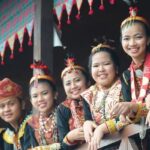We explain what urban tribes are, their function in adolescence and why they are subcultures. Also, examples and characteristics.

What are urban tribes?
An urban tribe is a group of individuals, generally young or adolescent, who share a daily way of dressing, their own language and, in general, a series of consumer habits and tastes, typical of a modern, city environment. This is one of the most common forms of grouping of young individuals in contemporary society.
Urban tribes are, in essence, identities shared as a group and expressed through certain habits and behaviors. Many understand them as a way to navigate the complexities of adolescence and youth, clinging to a group identity and ideology, capable of providing a sense of belonging, very important during certain stages of life.
In sociological and anthropological terms, however, urban tribes are part of what is known as “subculture”: a massive sociocultural expression, but underlying the official or hegemonic culture. That is to say, a culture that subsists within another larger, more formal culture as are the traditional cultures of each country.
In this way, a young person belonging to a specific urban tribe can have things in common with another person from a very distant and different culture and country. These types of experiences are typical of the globalized society and are facilitated by relationships through the Internet.
These are marginal, minority groups that resist traditional society, but at the same time they undertake an urban model of life typical of global and post-industrial capitalism. Music, technology, fashion and fictional imagery (stories, symbols, etc.) are central elements in each of the tribes, whose identity can end up being stereotypical, that is, easily recognizable.
The urban tribes change over time, they are born and die like any other collective phenomenon, and adapt to new aesthetic, social and technological scenarios.
That is why they are considered an important anthropological expression, which proposes certain models of connection and association within the community: many of them form “gangs”, promote “congresses” or mass meetings, and in general mobilize a large amount of digital information on networks. social and other spaces of exchange.
Examples of urban tribes

As we have said, urban tribes tend to continually change and reinvent themselves and disappear, and many of them are specific to a specific geographic region, at least until they become popular and globalized. The best known of them are, as an example, the following:
- Hippies. Appearing between the 1960s and 1970s, this is probably the oldest urban tribe that exists. Their values of anti-militarism, pacifism, anti-consumerism, and promotion of free love and sex have been inherited by many other later urban tribes. Hippies (or hippies) are recognized by their disheveled or informal look, passive and hedonistic attitude, prone to drug use and a spiritual vision. new agewhich seeks to connect with ancient traditions or other cultures.
- Punks. Associated with the musical movement of the 1980s, as well as a rebellious and combative attitude towards society and politics, it is one of the oldest urban tribes that still survives, although adapted to new times. They are characteristic of punk (or punks, punketsetc.) their clothing with abundant leather and combat boots, piercings and tattoos, colorful mohawks and radical haircuts, as well as their nihilistic slogans (there is no future) and an ideology that oscillates between the apolitical and the revolutionary.
- Geeks or geeks. Initially, these terms were used for any fan of technology, certain games or video games, or certain learning topics (astronomy, mythology, etc.), whose devotion was considered “excessive” or unusual. However, the massification of these hobbies gave rise to the urban tribe of geeks (mostly fans of technology) or geeks (mostly fans of fantasy and comics). Currently it is an urban tribe with very variable traits, of people prone to introversion and shyness, to world 2.0, role-playing games and horror and fantasy stories.
- Otakus With this Japanese name with very specific uses in its mother tongue (it is basically an honorific form of the second person), an entire urban culture born in the early 1990s in the West was baptized, and characterized by devotion to the Asian world. , particularly Japanese, and especially for its comics and animations. Otaku are recognized by their quirky, futuristic clothing, and their taste for comic and anime conventions, where they often dress up as their favorite characters (cosplay).
- Emo. Its name comes from “emotional” (“emotional” in English), and emerged in the early 1990s in the United States, linked to certain pop/rock genres. However, their greatest popularization took place during the 2000s, as heirs of the depressive and suicidal aesthetics of other later and extinct urban tribes, such as the grungethe goths (goth) or the skate (skateboarders). Their clothing tends toward dark colors, the use of makeup and nail paint in both sexes, piercings and tattoos, hairstyles with bangs (usually covering one or both eyes), and their behavior is usually cynical and withdrawn.
- Gamers. This is the urban tribe of inveterate video game players, whose clothing and codes of conduct tend to be much more lax and varied than in the rest of the list, although always with the presence of elements from the world of video games, especially those considered retro either vintage. However, the “gamers” (Spain) of both sexes are recognized for dedicating a large amount of time to video games, and for decorating their homes with merchandising from the industry, as well as tattooing symbols of their important video games, and always being very aware of the latest developments in the industry, around which their way of life revolves.
Continue with: Urban population
References
- “Subculture” on Wikipedia.
- “What are urban tribes?” (video) in Cultura UAEH (Mexico).
- “Anthropological study of urban tribes” at the National University of the Center of the Province of Buenos Aires (Argentina).
- “Urban tribes: a 'new' way of relating” at the National University of Cuyo (Argentina).





